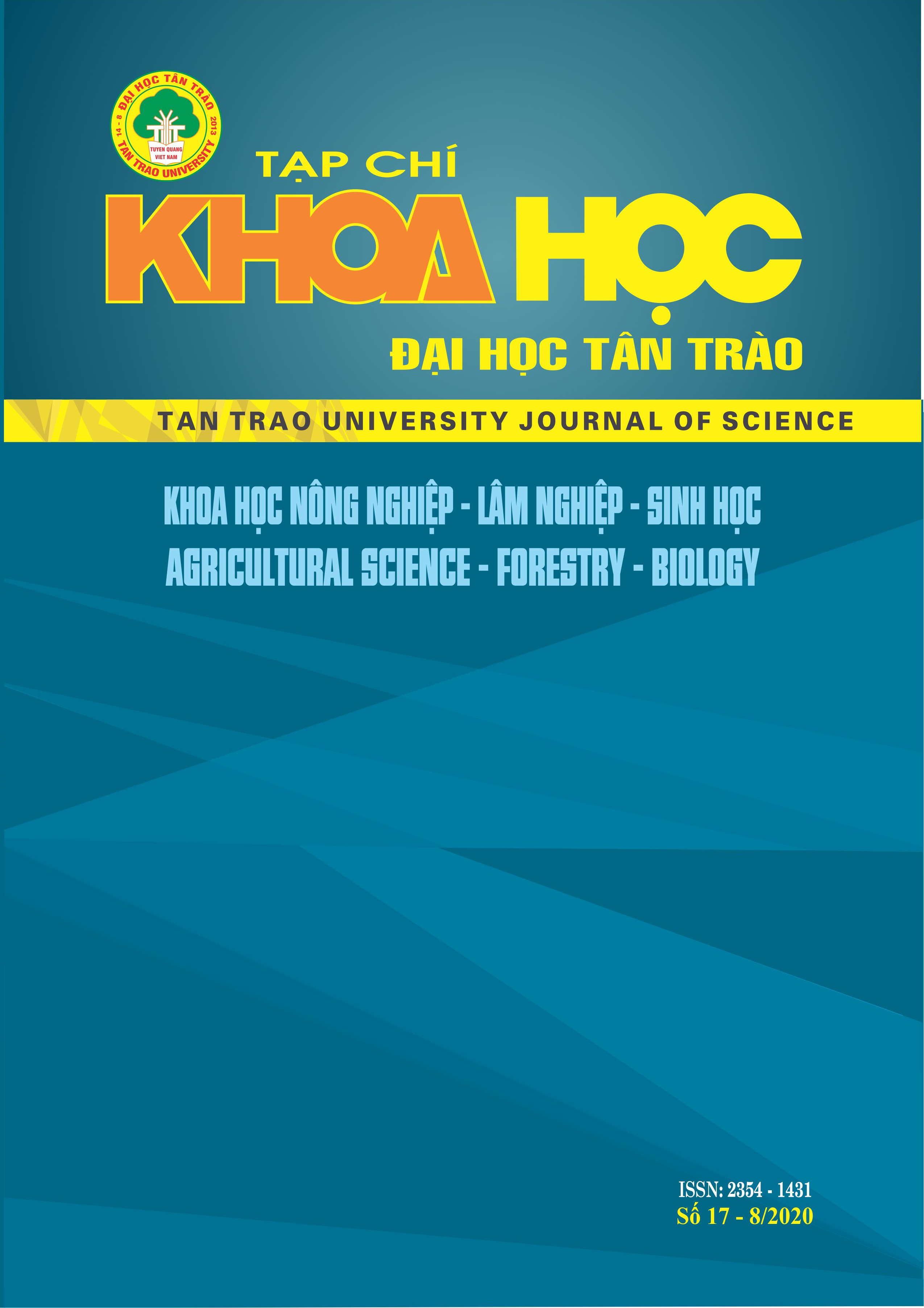Anti-inflammatory action from the leaf glue of vu bo (ficus hirta vahl.) Collected in Yen Son District, Tuyen Quang Province
DOI:
https://doi.org/10.51453/2354-1431/2020/384Keywords:
Ficus hirta, Moraceae, treatment, anti-inflammatory, IC50.Abstract
Ficus hirta Vahl is a tropical plant widely used in traditional Vietnamese and Chinese medicine to relieve and treat many pathologies. It is used to treat treatment of nephritis, hepatitis, mastitis, rheumatism, cough ....The purpose of this research is to scientifically demonstrate the anti-inflammatory of the leaf glue of Ficus hirta Vahl. The anti-inflammatory action of leaf glue was evaluated by inhibition NO production in RAW cells 264.7. Results showed that leaf glue of n-hexane; ethyl acetate, n-butanol with IC50 values respectively: 10.46; 13,16; 98.57 mg / ml. Therefore, Ficus hirta Vahl has great potential in treating and supporting the treatment of inflammatory diseases.
Downloads
References
1. Tai-Ming Shao, Cai-Juan Zheng, Chang-Ri Han, Guang-Ying Chen, Chun-Yan Dai, Xiao-PingSong, Jin-Chao Zhang, Wen-Hao Chen. (2014). Lactones from Ficus auriculata and their effects on the proliferation function of primary mouse osteoblasts in vitro. Bioorganic & Medicinal Chemistry Letters 24, 3952-3955.
2. Pham Hoang Ho, (2000), Vietnamese plants. Publisher: Young - Ho Chi Minh City, Vol. 2, p. 551-581.
3. Do Tat Loi, (2004), Vietnamese medicinal plants and medicinal herbs.Publishiner: Medical , p. 915.
4. Do Si Hien, Do Thi Xuyen (2011), the flora species of the Muong ethnic group in the Hang Kia-Pa Co nature reserve, used as medicine to treat kidney disease. National Scientific Conference on Ecology and Biological Resources 4th, p. 1121 to 1123.
5. Ya J, Zhang XQ, Wang Y, Zhang QW, Chen JX, Ye WC, (2010), Two new phenolic compounds from the roots of Ficus hirta. Nat Prod Res. 24,621-625.
6. Zheng RR, Wang WJ, Yang HB, Zhang QW, Zhang XQ, Ye WC, (2013), Chemical studies on roots of Ficus hirta. China Journal of Chinese Materia Medica. 38, 3696-3701.
7. Cheng J, Yi X, Wang Y, Huang X, He X, (2017), Phenolics from the roots of hairy fig (Ficus hirta Vahl.) exert prominent anti-inflammatory activity, Journal of Functional Foods. 31, 79-88.
8. Cheng J, Yi X, Chen H, Wang Y, He X. (2017), Anti-inflammatory phenylpropanoids and phenolics from Ficus hirta Vahl, Fitoterapia 121, 229-234.
9. Wan C, Chen C, Li M, Yang Y, Chen M, Chen J. (2017), Chemical constituents and antifungal activity of Ficus hirta Vahl. Fruits. Plants. 6, 44-52.
10. Lio H, Banbury L, Liang H, Wang X, Lu X, Hu L, Wu J (2014), Effect of Honghua (Flos Carthami) on nitric oxide production in RAW 264.7 cells and α-glucosidase activity. Journal of Traditional Chinese Medicine 34(3): 362 - 368.
11. S Combet, J L Balligand, N Lameire, E Goffin, O Devuyst (2000), A Specific Method for Measurement of Nitric Oxide Synthase Enzymatic Activity in Peritoneal Biopsies. Kidney International 57(1): 332 - 8.
12. Po-Jung Tsai , Tzung-Hsun Tsai , Chun-Hsien Yu , Su-Chen Ho (2007), Comparison of NO-scavenging and NO-suppressing activities of different herbal teas with those of green tea. Food Chemistry, 103(1), 181-187.
13. Natalia R. Bernardes, Marlon Heggdorne-Araújo, Isabela F. J. C. Borges, Fabricio M. Almeida, Eduardo P. Amaral, Elena B. Lasunskaia, Michelle F. Muzitano, Daniela B. Oliveira (2014), Nitric oxide production, inhibitory, antioxidant and antimycobacterial activities of the fruits extract and flavonoid content of Schinus terebinthifolius. Revista Brasileira de Farmacognosia. 24 (6), 644 - 650.
14. Sarot Cheenpracha , Eun-Jung Park, Bahman Rostama, John M Pezzuto, Leng Chee Chang (2010), Inhibition of Nitric Oxide (NO) Production in Lipopolysaccharide (LPS)-activated Murine acrophage RAW 264.7 Cells by the Norsesterterpene Peroxide, Epimuqubilin A. Mar Drugs. 8(3): 429 - 437.
Downloads
Published
How to Cite
Issue
Section
License

This work is licensed under a Creative Commons Attribution-ShareAlike 4.0 International License.
All articles published in SJTTU are licensed under a Creative Commons Attribution-ShareAlike 4.0 International (CC BY-SA) license. This means anyone is free to copy, transform, or redistribute articles for any lawful purpose in any medium, provided they give appropriate attribution to the original author(s) and SJTTU, link to the license, indicate if changes were made, and redistribute any derivative work under the same license.
Copyright on articles is retained by the respective author(s), without restrictions. A non-exclusive license is granted to SJTTU to publish the article and identify itself as its original publisher, along with the commercial right to include the article in a hardcopy issue for sale to libraries and individuals.
Although the conditions of the CC BY-SA license don't apply to authors (as the copyright holder of your article, you have no restrictions on your rights), by submitting to SJTTU, authors recognize the rights of readers, and must grant any third party the right to use their article to the extent provided by the license.


